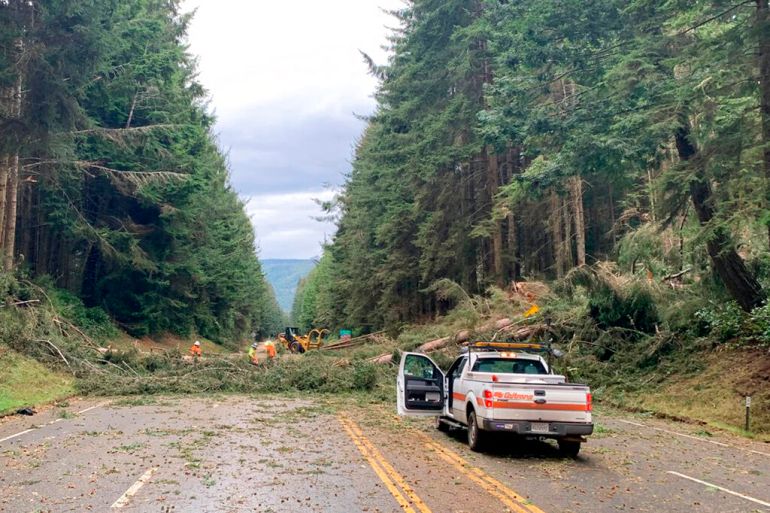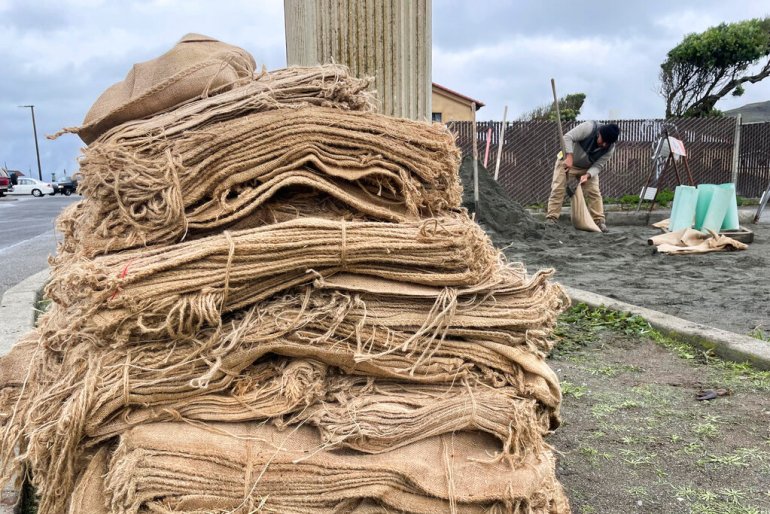California declares state of emergency ahead of incoming storm
Heavy rainfall expected to cause flooding and power outages across the state, with tornados in other parts of the US.

Powerful winds roared into California in the western United States on Wednesday, toppling trees as crews rushed to clear storm drains and residents fortified their homes in preparation for flooding and power outages.
California Governor Gavin Newsom declared a state of emergency to allow for a quick response and to aid in the cleanup after another powerful storm pummelled the state just days earlier.
Keep reading
list of 3 itemsDeadly US storm disrupts Christmas plans, downs power lines
California announces end of ‘peak fire season’ after subdued year
Dozens of flights were cancelled at the San Francisco International Airport and South San Francisco schools preemptively cancelled Thursday classes for their 8,000 students “out of an abundance of caution”.
As the storm intensified, state officials asked drivers to stay off the roads unless absolutely necessary and to stay informed by signing up for updates about downed trees and power lines, as well as flooding. In Northern California, a 40km (25 miles) stretch of Highway 101 was closed between the towns of Trinidad and Orick due to several fallen trees.
A strong system will bring heavy rainfall Wednesday – Thursday. Expect areas of urban flooding, and rising streams, creeks, and rivers. Stay alert if living near streams and creeks, follow evacuation orders, and be especially cautious driving at night. pic.twitter.com/7YteBvgf1r
— CAL FIRE (@CAL_FIRE) January 4, 2023
“We anticipate that this may be one of the most challenging and impactful series of storms to touch down in California in the last five years,” said Nancy Ward, the new director of the California Governor’s Office of Emergency Services.
The storm, set to be in full force in Northern California by Wednesday evening, is one of three so-called atmospheric river storms in the last week to reach the drought-stricken state.
Atmospheric rivers take the form of a concentrated band of moisture, capable of dumping heavy rain along a long, narrow region. But because California’s major reservoirs are at a record low from a dry three-year period, they have plenty of room to fill with more water from the impending storm, officials said.
Still, trees are already stressed from years of limited rain. Now that the grounds are suddenly saturated and winds are strong, trees are more likely to fall. That could cause widespread power outages or create flood hazards, said Karla Nemeth, director of the state’s Department of Water Resources.
“We are in the middle of a flood emergency and also in the middle of a drought emergency,” Nemeth said during an emergency briefing.
The state’s drought is now entering its fourth year, with the US Drought Monitor showing that most of the state is in severe to extreme drought.

The storm comes days after a New Year’s Eve downpour led to the evacuations of people in rural Northern California communities and the rescue of several motorists from flooded roads.
A few levees south of Sacramento were damaged. And in the San Francisco Bay Area, the 8,500 sandbags distributed by officials were not enough to satisfy demand on Wednesday as forecasters warned of imminent flooding.
Heavy downpours accompanied by winds with gusts of up to 96 kph (60 mph) were expected later on Wednesday and through Thursday, making driving conditions difficult, the National Weather Service said. In Southern California, the storm was expected to peak in intensity overnight, with Santa Barbara and Ventura counties likely to see the most rain, forecasters said.
Aaron Johnson, Pacific Gas & Electric regional vice president for the Bay Area, said the company had more than 3,000 employees working in crews of three to five people to assess damage and restore power as soon as possible.
Elsewhere, in the Midwest, ice and heavy snow took a toll this week, closing down schools in Minnesota and western Wisconsin and causing a jet to go off an icy taxiway after landing in a snowstorm in Minneapolis. No passengers were injured, Delta airlines said.
To the south, a possible tornado damaged homes, downed trees and flipped a vehicle on its side in Montgomery, Alabama, early on Wednesday. Christina Thornton, director of the Montgomery Emergency Management Agency, said radar indicated a possible, but unconfirmed, tornado. The storm had extremely high winds and moved through the area before dawn, she said.
Staff from the National Weather Service’s Chicago office planned to survey storm damage on Wednesday following at least six tornados, the largest number of rare January tornadoes recorded in the state since 1989.